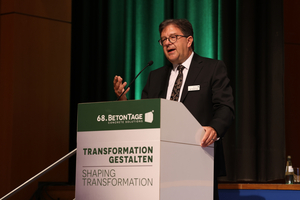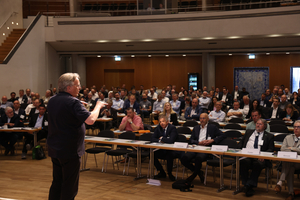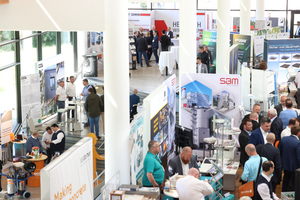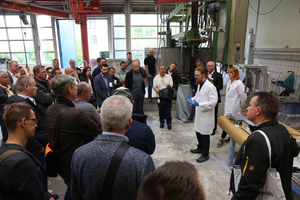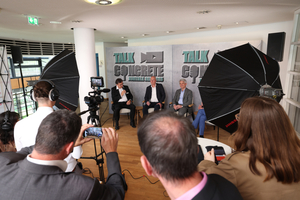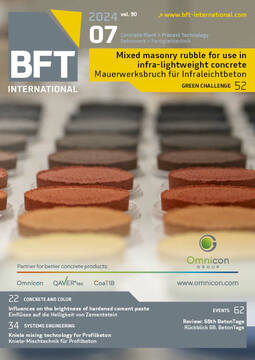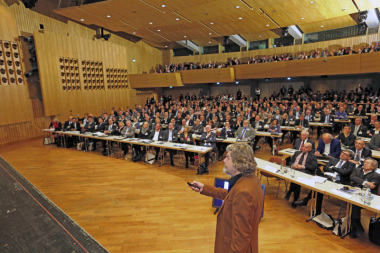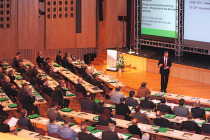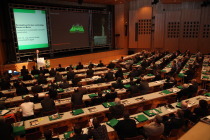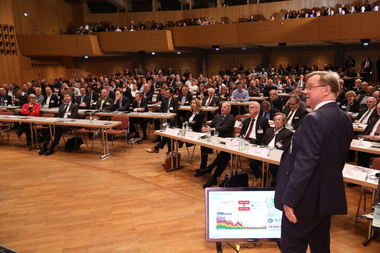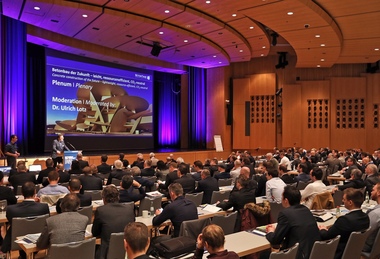Impetus for sustainable building with concrete and concrete elements
The annual BetonTage took place from 14 to 16 May 2024 at the Congress Centrum Ulm under the motto “Shaping Transformation.” The fully booked exhibition was attended by around 1800 persons and included 140 exhibitors from the supplier industry and 10 start-ups – and featured more than 120 presentations.
Challenges and perspectives
The industrial event was opened by Friedrich Gebhart, Vice-President of the European umbrella organization BIBM and President of the initiating Trade Association of Concrete and Precast Plants in Baden-Wurttemberg. For Gebhart, the motto signifies “presenting concrete solutions at the BetonTage for significant reduction of the CO2 footprint in construction.”
In the face of a decline in building permits and orders received in housing construction by up to -30%, a peak in cancellations, revoked subsidy programs, high interest rates and high construction costs, it is especially the attending exhibitors of the supplier industry who offer opportunities for building the future. BetonTage is a platform for joint discussion of shaping such transformation.
All named and unnamed indispensable stakeholders – such as architectural offices and engineering firms – were present and, for the duration of the event, responded to the appeals made. These calls included lectures from science and practice focused on sustainability and decarbonation, resource efficiency and recyclability as well as on sustainable prefabrication as the future of building.
Digitization was also a focal-point topic and was introduced by Jörg Heynkes’ engaging keynote lecture “Why we will save the world digitally – or not at all.” Heynkes described, based on future prognoses and visual examples, how it was high time to use state-of-the-art technologies, to develop awareness and passion for making our society fit for the future and to ensure the survival of mankind.
Werner Loscheider from the German Federal Ministry of Economic Affairs and Climate Protection (BMWK) followed up on Heynkes’ lecture. For environmental and climate protection by saving resources, he described the considerable potential of lightweight construction as a product-independent approach. With its initiative Lightweight Construction, BMWK has since 2016 supported material- and technology-wide exchange and knowledge transfer among the various stakeholders involved.
A video message by Manfred Curbach followed, describing the planned construction of the LAB Construction Research Center in Bautzen: LAB means Living Art of Building. In November of 2023, the Budget Committee of the German Parliament approved a total of 68.6 million euros for the Construction Research Center, to function under the name LAB over the coming five years. A number of German Federal States and/or Administrative Districts have also pledged their support. The development of LAB over a period of several years is set to begin in mid-2024. Following the development phase, a total of around 1,250 scientists will conduct research and development in the LAB, which would be an internationally unique laboratory facility. This would make LAB the largest research center of its kind. Owing to its close collaboration with industry, LAB predicts long-term creation of up to 40,000 jobs in and around its activities.
A special guest in 2024 was Stephen Foster, President der Fédération internationale du béton (fib), from Australia. Foster praised the BetonTage with its annual meeting of internationally leading experts as melting pot for ideas and solutions that pave the way for an ecological future.
Future of building with prefabrication
Important solutions for the future of building were vigorously discussed already on the first afternoon at Panel 1, organized by the FDB – the Association of German Precast Construction.
The focus here was on the new mindset as practiced by such future-viable precast companies as Brüninghoff. Dr. Jan Wenker, Thomas Trieb and Frank Steffens explained the company’s focus on ongoing enhancement of sustainable performance in planning, implementation and day-to-day operation.
Based on the latest revision of the FDB planning guidelines, the building assessor Alice Beck described how sustainable building with precast elements could look as a result of reduction of CO2 emissions in structural design, modification of the composition of concrete and enhancement of the production process. Emphasis in the presentation was also on planning appropriate for prefabrication and early participation of specialist planners and manufacturers.
As is well known, climate change brings about warming of the urban climate, which can be counteracted with green spaces and trees. At the Panel Discussion of Urban Design of Living Spaces, organized by the German Concrete Association for Road, Landscape and Garden Construction (SLG), the presentation of wall-bound, vertical greening of precast elements, presented by architect Adrian Birkenmeier, was a particular highlight. The Green Wall is suitable as façade, concrete wall or freestanding privacy and noise protection wall and combines building shell and greening in one wall element.
Among the presentations at Panel 2 was the SLG Technical Data Sheet on Cleaning and Protection of Cast-Stone Block and Slab Pavements.
Company succession, illustrated by the entrepreneur Ulrich Rekers using the example of the precast industry, dominated the topic area at Panel 3 on Economy and Law. In-house lawyer Jörg Jehle, from the Concrete Associations of Baden-Württemberg, gave an update on this topic by using industry-relevant legislation and case law as an example. The presentations were supplemented by attorney-at-law Stefan Schicker on AI.
Serial and modular – but mineral-based, please!
The name of the Plenum on the second day said it all and was passionately described in a lecture by Dr.-Ing Michael Six of Goldbeck Südwest GmbH. Using Goldbeck philosophy as a basis, he very impressively described how sustainable serial construction can be consistently implemented: “We owe much of our prosperity to concrete, which has been used to construct the lion’s share of our buildings and infrastructure. Concrete during its life cycle turns out to be completely different, perhaps even unrivaled.”
At the Lightweight Concrete Panel conducted by the German Federal Association of Lightweight Concrete, the team associated with Prof. Karl-Christian Thienel and Dr. Mathias Köberl of the German Military University in Munich explained how resource-saving building with lightweight and infra-lightweight concrete can succeed. The lecture focused primarily on the use of recycled lightweight aggregate and on CO2 absorption by lightweight concretes. At Panel 6 on Lightweight concrete, Ahmad Iravani of the German Federal Association of Lightweight Concrete additionally presented the roadmap of the German Federal Association for a CO2-free industry by 2045.
In addition to the use of lightweight concrete, constructing more slender buildings is another possibility for CO2 saving in precast construction. This was also the topic of the Cast Stone Panel moderated by Martin Möllmann from the Informationsgemeinschaft Betonwerkstein (Info-b e.V.). Along with projects such as the stair flights and terrazzo floors in the SAB Bank in Leipzig, presented by Jörg Bayer, innovative binding agents were described by Stefan Bechtoldt (Dyckerhoff GmbH) and Dr.-Ing. Stephan Hauser, from Ducon Europe GmbH & Co. KG. In his lecture, he discussed more slender, more sustainable cast stone made with UHPCs.
The potential for CO2 saving in precast construction, especially in the context of carbon concrete, was another topic of the Panel on Lightweight Construction, moderated by Roy Thyroff of Composites United. In his lecture Volker Roth (vorobis) discussed the many advantages of carbon concrete.
In the following lecture, Dr.-Ing. Oliver Heppes (Carbon 360 GmbH) explained how precast carbon concrete elements are designed to be resource-saving and cost-efficient. A similar focus was followed by Prof. Thomas Engleder, Prof. Andreas Häger, Prof. Robert Schneider and Iris Veloso in their presentation on the Rebweave Project at Aalen and Ulm Universities, which covered the topic “CO2 reduction by machine-made reinforcement mats made of basalt-fiber reinforced plastic.”
New thinking and innovative impulses
Once again this year, innovative approaches were presented by the start-ups at the BetonTage: ranging from the start-up area in the exhibition to lectures by the company Berner Neustark AG. The approach here was on how CO2 in demolition concrete and concrete mixing water – as well as in other mineral waste streams of construction material from recyclers and concrete plants – are mineralized and how concrete acts as a CO2 sink.
The Innovation Prize of the Supplier Industry for Concrete Components 2024 was also awarded to a start-up: to Sonocrete GmbH, which introduces ultra-sound technology into concrete production for significantly increasing early strength by use of cements with greatly reduced CO2 – which in turn results in marked decrease of carbon emission.
The presentation of this company from Cottbus, Germany, was also integrated for the first time into a mobile model configuration in the practical workshop at the Ferdinand-von Steinbeis Vocational School.
In the workshop where the Sonocrete demonstration took place, Sönke Hansen also presented digitation of fresh-concrete characteristics with Qavertec technology. In the afternoon, he also demonstrated a digital Darr test on fresh concrete. Following this, Karl-Heinz Kleih gave a very authentic and hands-on demonstration of how sustainable use of various forming materials for special precast elements can look.
Likewise, hands-on impulses naturally also came directly from the supplier industry. At the Innovation Forum, moderated by Dr. Thomas Kranzler (Syspro-Gruppe Betonbauteile e.V.) and Silvio Schade (BFT International), a total of 16 exhibitors presented their innovative solutions over the entire bandwidth of the industry. These solutions ranged from reinforcement and fastening technology, recycling and measuring technology, CO2 saving and resource preservation and digitation to AI in the precast industry.
Future Day presentation for the building industry
On the third day, Thomas Möller, General Manager of Building Industry for Baden-Württemberg, opened the Building Industry Future Day. Together with Thomas Zawalski, he gave an overview of the progress Solid Unit has made with its network for innovative solid construction.
In the afternoon, the Building Industry Future Day and the Panel on Concrete in Architecture addressed construction companies and architectural firms.
For these stakeholders, as well as all others, a change in perspective for shaping the new age is essential, cautioned Prof. Schwehr of Lucerne University in his speech for a new way of thinking in the construction industry. He stated that this would call for nothing less than reconstructing urban space and reorganizing its functions – from utilities to mobility, living, education and health care as well as leisure. Acting sustainably means keeping the future open for future generations.
Also at the Building Industry Future Day, Daria Kovaleva presented the Marinaressa Coral Tree from the Venice Biennale as an example for minimality, circularity and regenerability. A prototype of the coral tree, with an exact representation of its dimensions, made available by the ILEK of Stuttgart University, was used to embellish the title motif of this year’s Congress.
One of the outstanding projects involving concrete elements is the result of the work of Prof. Angelika Mettke (BTU Cottbus-Senftenberg) for reutilization of precast concrete slabs. Her holistically conducted investigations – into construction and environmental engineering parameters and construction materials, economic, ecological, logistic and social-cultural aspects – confirm that the investigated and previously used precast elements possess excellent functional characteristics.
The Plenum of architects, moderated by Michael Schuster (DBZ Deutsche Bauzeitschrift) also focused on sustainable urban design of work and living spaces.
Following in the afternoon was the presentation of all three prize-winning projects for the Concrete Architecture Prize, awarded by the collaboration partner Information Center Concrete (IZB).
Transformation of the industry
In all, a motivating upwind blew through the event – despite and especially because of the somewhat disturbing starting situation on the market. A clear “Now more than ever” and “Let’s get going” provided the accompanying and upbeat tenor of the many presentations and talks that did not let up in any panel.
New ideas are being put to the test everywhere in the industry. Switches are being thrown and concepts are being put into action: the combined strength of all stakeholders is necessary to master the challenges of our time and – in the words of Jörg Heynkes – to put ideas into action. This was clearly felt in the panels. The passion evident shows that building – and the concrete sector in particular – are in no way lethargic: on the contrary, the opposite is the case. This passion shows that building and especially the concrete sector are in no way sluggish: rather, that the transformation of our time is very active and innovative in the direction of decarbonation, digitation and circular economy.
BetonTage will continue to be a platform for driving this transformation and for an exchange of ideas in their presentation. The 59th BetonTage will take place from 11 to 13 March 2025 in a new format. Details will follow.
CONTACT
FBF Betondienst GmbH
Gerhard-Koch-Str. 2+4
73760 Ostfildern/Germany
+49 711 32732-322

